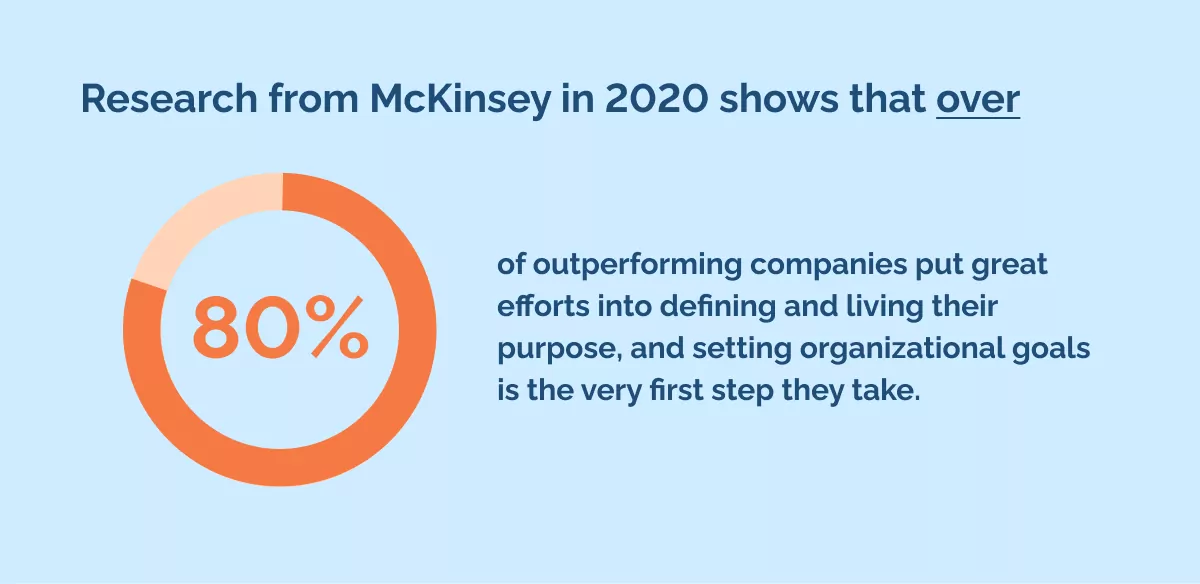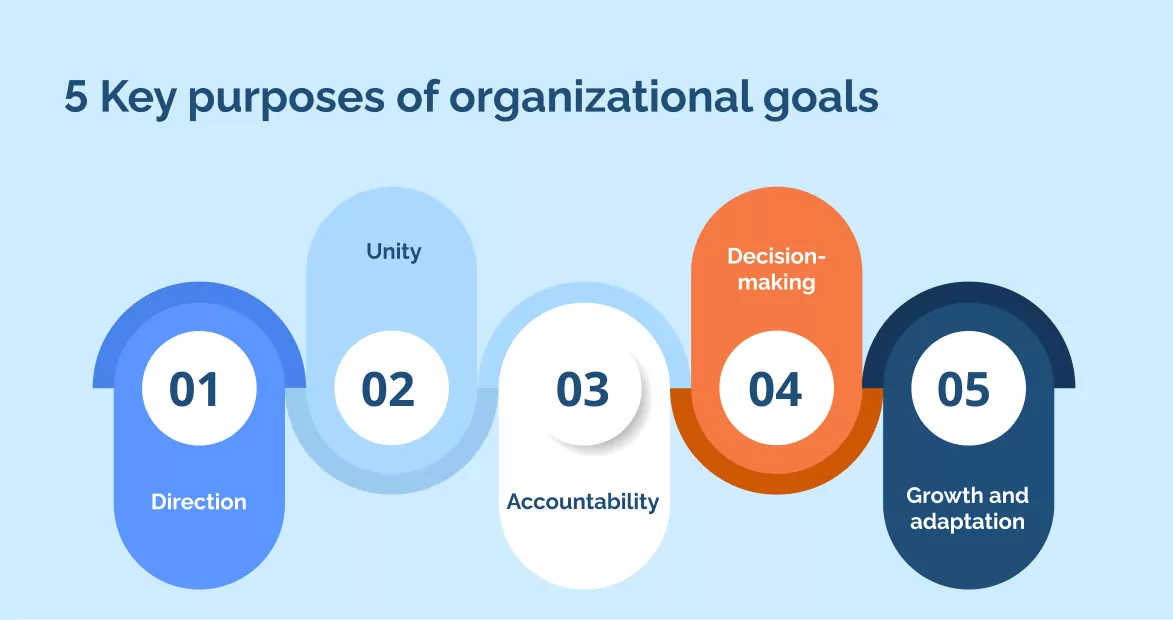
Organizational goals are the specific objectives you set for your business.
They provide a roadmap for where you want your business to go and offer measurable outcomes to gauge success.

Research from McKinsey in 2020 shows that over 80% of outperforming companies put great efforts into defining and living their purpose, and setting organizational goals is the very first step they take.
Setting organizational goals is the foundation of successful change management— but that alone isn’t enough.
How do you define and set organizational goals?
How do you encourage your employees to adopt those goals?
How do you align your technology strategy with your organizational goals?
In this article, we’re going to answer all those questions and more. We’ll dive deep into what these goals mean, discover their importance, learn about different types, understand their purposes, and get insights into setting them effectively for your organization.
Understanding organizational goals
At the heart of every thriving business lie well-defined organizational goals.
These are the specific ambitions you set for your company, steering its direction and defining its purpose.
It should be noted there are nuances between organizational goals and individual or departmental objectives.
Organizational goals pertain to the entire organization’s aspirations. They paint a holistic picture of where you want the business to be in the future.
On the other hand, personal or departmental objectives are more segmented. They’re tailored to specific departments or individuals, focusing on tasks or targets that contribute to the larger organizational goal.
Essentially, while organizational goals set the course, personal or departmental objectives lay out the steps you and your teams need to take to get there.
4 reasons why organizational goals matter

Let us convince you if you’re not sold on the importance of setting clear and powerful organizational goals.
The benefits can seem vague to begin with, so we’ve carved out these 4 reasons why organizational goals are important for everything from successful change management to effective leadership.
1. Aligning efforts
When you set clear organizational goals, you ensure that every member of your team is moving in the same direction.
It fosters a unified vision, ensuring that departments and individuals aren’t pulling in divergent directions but are collaboratively driving your company toward a shared aspiration.
2. Performance measurement
That said, organizational goals aren’t just aspirations but yardsticks.
By establishing these goals, you create benchmarks against which you can measure your company’s progress.
Whether it’s a quarterly review or an annual appraisal, these goals help you identify areas where you’re excelling and areas needing improvement.
3. Motivation
There’s something inherently motivating about a clear target.
When your employees understand the organization’s goals, they can see the bigger picture, their role within it, and the impact of their contributions.
This clarity provides a sense of purpose and fuels their drive to achieve more.
4. Resource Allocation
Every resource at your disposal, be it time, money, or manpower, is finite.
Organizational goals act as a beacon, guiding you on where to invest these resources for maximum impact.
By aligning resource allocation with organizational goals, you ensure that every decision you make propels your business closer to its objectives.
5 Types of organizational goals

If you’ve a keen eye you might have noticed we’ve been saying “goals” and not “goal”.
That’s because there are 5 different types of organizational goals. Each serves a different purpose, and you need to be aware of them all.
Some organizational goals are multiple types, so you shouldn’t think of this list as a checklist.
Rather, you should simply use it to further your understanding of what organizational goals are, and what they do.
1. Short-term vs. long-term goals
In planning, distinguishing between immediate objectives (spanning weeks to a year) and broader aspirations that may take several years is crucial.
Short-term goals tackle present challenges and opportunities, providing immediate milestones and motivation.
Long-term goals, however, set the future trajectory, ensuring sustained growth and evolution.
2. Operational goals
These objectives keep the daily workings of your business on track.
They’re your day-to-day targets that ensure routine operations, from production to customer service, are efficient and consistent.
They are the backbone that supports the business’s daily functions.
3. Strategic goals
These are your big-picture objectives, the visions you aim to realize in the years to come.
Whether it’s penetrating a new market, achieving a notable market share, or launching innovative products, strategic goals chart the course for your organization’s future.
4. Tactical goals
To bring strategic goals to fruition, you need actionable steps.
Tactical goals are these steps.
They’re the specific tasks and initiatives that, when executed, inch you closer to your overarching objectives.
If your strategy is the destination, tactics are the journey.
5. Process vs. outcome goals
Recognizing the difference between the journey (process) and the destination (outcome) is pivotal in goal setting.
Process goals emphasize the actions, behaviors, and methods you adopt, while outcome goals spotlight the results you aim to achieve.
Balancing both ensures a holistic approach to planning and execution.
5 Key purposes of organizational goals

We know you’re thinking it:
What is the point?
Okay, okay. We’ll cut to the chase. Here are 5 of the key purposes of organizational goals. This is why you should set them:
1. Direction:
Providing a clear path lays the foundation for any successful organization.
With well-defined goals, you can ensure that your business moves forward with purpose, clarity, and focus.
2. Unity:
By establishing shared organizational goals, you foster a sense of unity and common purpose among your teams.
It ensures that despite varied roles and responsibilities, everyone works towards the same end.
3. Accountability:
Setting goals means setting expectations.
With clear objectives in place, you can hold departments and individuals accountable, ensuring they contribute effectively to the business’s overall success.
4. Decision-making:
Goals serve as a guiding light in the decision-making process.
Whether you’re contemplating a new investment, a partnership, or any other business move, your goals will help ensure your choices align with the organization’s long-term vision.
5. Growth and adaptation:
The business world is in constant flux.
Organizational goals not only guide current strategies but also allow room for adaptation and evolution in changing markets and scenarios.
Setting clear objectives ensures that your business remains relevant and continues to grow, irrespective of external challenges.
How to set effective organizational goals

If you feel like you’re ready to carve your organizational goals into stone, we’ve got 5 top tips to help you create effective goals that let you live your purpose.
Adopting these strategies will put you on a path to creating organizational goals that not only inspire but also deliver tangible results.
1. S.M.A.R.T criteria
To set impactful goals, adopting the S.M.A.R.T framework can be immensely beneficial.
This approach ensures that your goals are:
Specific: Clearly defined, leaving no ambiguity.
Measurable: Quantifiable, allowing you to track progress.
Achievable: Realistic, considering your organization’s resources and constraints.
Relevant: Aligned with your business’s direction and current market dynamics.
Time-bound: Set within a specific timeframe to ensure focus and timely achievement.
2. Involve stakeholders
Effective goal-setting isn’t a one-person job— and this is the single biggest mistake most business leaders make when setting organizational goals.
In 2022 Mckinsey found that 48% of employees feel like they don’t have a say in their team’s purpose. On top of that, 44% disagreed when asked if they feel empowered to challenge organizational goals.
By involving stakeholders from various levels of your organization, you can tap into diverse perspectives, ensuring comprehensive and well-rounded goals.
This collaborative approach not only enriches the goal-setting process but also fosters ownership and commitment across the board.
3. Regular review
The business landscape is ever-evolving, and so should your goals.
Regularly revisiting your objectives allows you to gauge progress, recognize shifts in the market, and adjust your strategy accordingly.
Whether it’s due to unforeseen challenges, new opportunities, or performance data, periodic reviews ensure your goals remain relevant and achievable.
4. Align with vision and mission
Your organizational goals should be a reflection of your overarching vision and mission.
Ensuring this alignment means that every goal, whether short-term or strategic, echoes the core values and aspirations of your business.
It provides coherence and direction in every endeavor you undertake.
5. Prioritize:
While it’s tempting to pursue every opportunity that comes your way, it’s essential to discern which goals will have the most significant impact.
By prioritizing, you can allocate resources effectively, focusing on goals that drive the most value while keeping secondary objectives in perspective.
Organizational goals: A compass, a target, and a mission
Organizational goals are more than just strategic markers; they’re the lifeblood of a thriving enterprise.
They sculpt the contours of an organization’s journey, offering direction, fostering unity, and catalyzing growth.
When woven into the fabric of a company, these goals ensure every decision, every effort, and every resource is channeled toward a collective aspiration.
For leaders and managers, the act of setting organizational goals is not a one-time task but an ongoing commitment. As the business environment evolves, as challenges emerge, and as opportunities present themselves, it’s imperative to continuously refine and refocus these goals.
Doing so ensures that your organization remains agile, relevant, and poised for success.
WalkMe Team
WalkMe spearheaded the Digital Adoption Platform (DAP) for associations to use the maximum capacity of their advanced resources. Utilizing man-made consciousness, AI, and context-oriented direction, WalkMe adds a powerful UI layer to raise the computerized proficiency, everything being equal.



